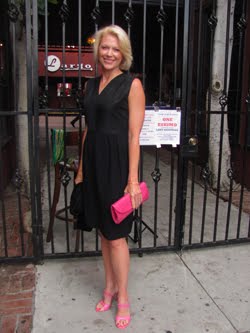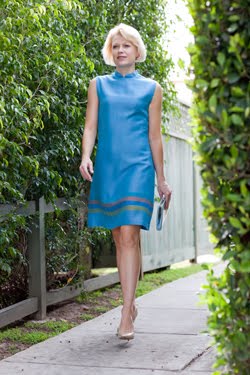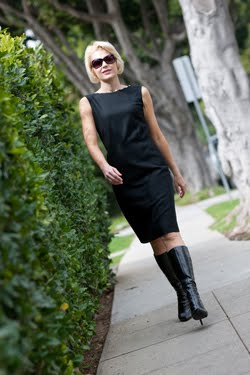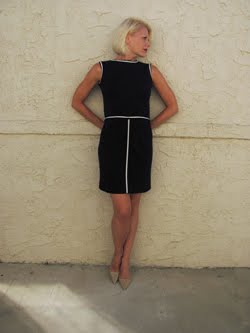ABOVE: lemon chiffon dream fit for Lana Turner in the window at Mon Atelier
Edith Head at her Paramount salon with Grace Kelly preparing for To Catch a Thief
The design talent behind Mon Atelier is Ali Rahimi, a couturier whose brilliance appeared early in life; family found him creating clothes as a mere 6-year-old. He studied design at school then worked his way through the fashion industry from sourcing to pattern making (the key to a great production process) to full-time design. His love for classic cinema informed his design as well as the steadfast belief that the right dress makes a woman come to life. Thus, he decided on a course of custom-made couture and started Mon Atelier in 1990. He and partner John Barle opened their boutique on La Brea Avenue in 1996 and customers came running, including many second generation Hollywood like Mariska Hargitay (Jayne Mansfield's daughter), Joely Fisher (Connie Stevens' daughter), and Anjelica Huston (John Huston's daughter). Oscar nominees Angela Bassett and Amy Adams are also among their fans. As a testament to their timeless style, their clothes have been worn by girls of all ages--from a 3-month-old in a wedding to a 94-year-old Carol Channing when she performed at the Kennedy Center Honors.
I may not be a customer (yet), but I have experienced the luxury of Mon Atelier. When you arrive, the salon is bathed in a warm glow and walled with gowns in the most luxurious (often vintage) fabrics you've ever seen. Silks, sequins, feathers, and lace are all around you. It's hard to miss the infusion of Old Hollywood style, especially in the extraordinary craftsmanship of their built-in corsets and hand beading. I've enjoyed hours with Ali and John talking about classic cinema and fashion. For them, the connection is direct. They are well-versed in film history and sources of inspiration frequently come from costume designers Jean Louis and Helen Rose as well as stars like Lana Turner, Doris Day, and Loretta Young. In fact, anyone who works with the duo is given a list of required viewing, including Lana's Jean Louis wardrobe in Imitation of Life (1959) and one of my own Style Essentials Pillow Talk (1959).
Mon Atelier is known for gorgeous gowns, but they also have tailored suiting for women that is equally timeless in its design. In fact, I was first introduced to the brand by Patricia Ward Kelly--Mrs. Gene Kelly--at the TCM Classic Film Festival. There she stood on the red carpet in a perfectly cut navy suit from Mon Atelier, which made me immediately approach her. Because of my own classic style, we struck up a conversation that included her great compliment to me, "Gene would approve!" An introduction to Ali and John quickly followed as well as an invitation to the Centennial Tribute to Gene Kelly at the Academy of Motion Picture Arts and Science (AMPAS). There she looked radiant in Mon Atelier once again. And she wore yet another custom-made suit when she recently appeared on TCM to introduce Gene's greatest movies--such as An American in Paris and Singin' in the Rain--on what would have been his 100th birthday.
Everyone understands my passion for classic cinema and its incredible style, and Mon Atelier is some of the most perfect design I have ever seen. It captures the magic that we love from Old Hollywood costume design while making it absolutely modern for today. And because each of Ali's gowns, dresses, and suits are custom-made...well, you just have to feel like the luckiest woman in the world wearing them. So steady yourself, ladies. If you love fashion at its highest art form, Mon Atelier will positively set your heart racing.
Welcome to Mon Atelier
The sitting room is perhaps my favorite part of the salon
Mon Atelier is famous for luxurious fabrics that even include limited supplies of vintage
that are used to their best advantage in both men's ties as well as newly designed dresses
that are used to their best advantage in both men's ties as well as newly designed dresses
One wall of the atelier is full of color-blocked gowns
A favorite Little Black Dress--it's perfect, isn't it?
Speaking of perfection, you can see inspiration from Lana Turner
in their yellow and white goddess gowns...so much my own personal style
Ethereal gowns in white line the other side of the salon
I adore white dresses...look at the detail and design differences in these gowns
Caftans are all the rage and I adore this one in orange floral sequins
John capturing me in a mirror that once belonged to MGM (and possibly Helen Rose herself)
Time to say good-bye...for now
Meeting Patricia Kelly at the 2012 TCM Classic Film Festival in Mon Atelier suiting (above)
and once again at the Centennial Tribute to Gene Kelly at the AMPAS























































































































































